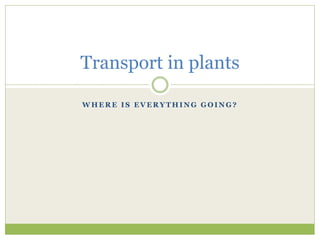Ch 9 transport in plants 2019
•Als PPTX, PDF herunterladen•
2 gefällt mir•991 views
Transport in plants 2019
Melden
Teilen
Melden
Teilen

Empfohlen
Weitere ähnliche Inhalte
Was ist angesagt?
Was ist angesagt? (20)
Ähnlich wie Ch 9 transport in plants 2019
Ähnlich wie Ch 9 transport in plants 2019 (20)
TRANSPORTATION IN PLANTS - CBSE (CHAPTER-9)NBIOLOGY

TRANSPORTATION IN PLANTS - CBSE (CHAPTER-9)NBIOLOGY
Mehr von Ruba Salah
Mehr von Ruba Salah (20)
Kürzlich hochgeladen
This presentation was provided by William Mattingly of the Smithsonian Institution, during the fourth segment of the NISO training series "AI & Prompt Design." Session Four: Structured Data and Assistants, was held on April 25, 2024.Mattingly "AI & Prompt Design: Structured Data, Assistants, & RAG"

Mattingly "AI & Prompt Design: Structured Data, Assistants, & RAG"National Information Standards Organization (NISO)
Kürzlich hochgeladen (20)
Z Score,T Score, Percential Rank and Box Plot Graph

Z Score,T Score, Percential Rank and Box Plot Graph
A Critique of the Proposed National Education Policy Reform

A Critique of the Proposed National Education Policy Reform
9548086042 for call girls in Indira Nagar with room service

9548086042 for call girls in Indira Nagar with room service
Mattingly "AI & Prompt Design: Structured Data, Assistants, & RAG"

Mattingly "AI & Prompt Design: Structured Data, Assistants, & RAG"
social pharmacy d-pharm 1st year by Pragati K. Mahajan

social pharmacy d-pharm 1st year by Pragati K. Mahajan
Interactive Powerpoint_How to Master effective communication

Interactive Powerpoint_How to Master effective communication
Disha NEET Physics Guide for classes 11 and 12.pdf

Disha NEET Physics Guide for classes 11 and 12.pdf
Ecosystem Interactions Class Discussion Presentation in Blue Green Lined Styl...

Ecosystem Interactions Class Discussion Presentation in Blue Green Lined Styl...
Ch 9 transport in plants 2019
- 1. W H E R E I S E V E R Y T H I N G G O I N G ? Transport in plants
- 2. Transport systems There are two transport systems in a plant. One that transports water and minerals from root to all other parts. These vessels are called …………. Another vessels transport sugars (sucrose) and amino acids made in leaves to all other plant parts. These are called phloem vessels.
- 3. Xylem vessels Are long , hollow, continuous tubes that carry water and dissolved minerals from the root up to all parts of the plant. Contain a tough substance called lignin that lines the walls to provide support.
- 4. Phloem vessels Phloem tubes are living cells with end tubes with pores (sieve plate). All cell contents have disappeared except the cytoplasm The phloem cells have companion cells near them. Phloem cells transport sucrose and amino acids from where they are made to where they are used or stored.
- 5. Dicot stem Dicot root Arrangement of xylem and phloem vessels
- 8. How water moves into the plant.
- 9. Experiments 1. measure water uptake by plant shoots. 2. Show that transpiration takes place in shoots. 3. Show there are more stomata on the lower side of a leaf.
- 10. How does water move up the plant? Water molecules tend to “stick” to the walls of their container. The narrower the container the higher water travels up. This helps plants because they have no pumps to push the water up in xylem vessels.
- 11. Transpiration It is the loss of water vapour out of leaves (and stems) through stomata by diffusion.
- 12. Potometer A potometer measures the rate of water uptake. The distance moved by the air bubble can be measured every minute to show the rate of water uptake. The air bubble can be moved back to the start position by……………………. Water is not only lost by transpiration in the leaves it is also used by the leaves during ………….….
- 13. Put your thinking caps on! Predict what would happen to the rate of water uptake if the temperature increases. When the wind speed increases? When light intensity increases? When humidity increases?
- 14. Transpiration is affected by Weather condition Rate of transpiration Why? Windy Speeds up transpiration Moist air around the leaf is blown away Humid Slows down transpiration Air around the leaf is already full of moisture Warm Speeds up transpiration Evaporation occurs faster Light Speeds up transpiration The stomata opens
- 16. Translocation Is moving food (sucrose and amino acids) from the sources (leaf, root) to sinks (developing flowers/fruits, storage organs) through the phloem vessels. 10
- 17. Xerophytes Adaptations of xerophytes to live in dry habitats: 1. Some have their leaves reduced to needle like structures to reduce their surface area. 2. The stems are swollen to store water such as cactus. 3. The stems are green to carry out photosynthesis. 4. The leaves & stem are covered with a thick waxy cuticle. 5. The roots grow deep in the soil & branch on the surface to absorb water when it rains. 6. The stomata are in deep grooves to reduce transpiration. 7. Many leaves have tiny hairs to trap water vapour around the leaf, increasing humidity. 10
- 18. Hydrophytes Adaptations of water plants: They have a thin cuticle. Stomata are open most of the time, & may be present on upper surface. They are less rigid, as they are supported by water & to prevent their damage by water currents. Large flat leaves to float, which usually contain many air sacs for flotation. Small roots, water can diffuse directly through leaves. 10 P. 100 610/31/J/11
